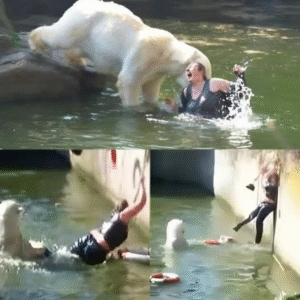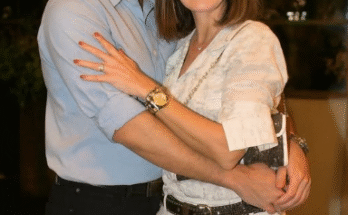On a crisp spring afternoon in Berlin, what was meant to be a routine day at the zoo turned into a terrifying spectacle that left visitors in shock, officials scrambling, and the entire city buzzing with questions. The Berlin Zoological Garden, one of Europe’s most renowned and oldest zoos, was filled with families, schoolchildren, and tourists. The polar bear enclosure—always a crowd favorite—stood as a symbol of both the majesty and danger of wild animals. But on that particular day, it became the site of an almost unthinkable incident: a woman deliberately entered the enclosure, placing herself face-to-face with one of the world’s most powerful predators.
Witnesses first noticed her around midday, standing near the protective railing that separated visitors from the bears. She appeared nervous, pacing back and forth, mumbling to herself, and ignoring the chatter of families around her. A few thought she was simply overwhelmed or upset, perhaps lost in her own thoughts. But suddenly, without warning, she climbed over the outer barrier and began making her way toward the secondary fence designed to keep the public at a safe distance.
Gasps rippled through the crowd. “What is she doing?” one father shouted, pulling his children back. At first, many thought it was a prank or some kind of protest—something dramatic but harmless. But as she continued, climbing past warning signs, it became horrifyingly clear that this was no act.
Within moments, the woman had made it past both sets of barriers and dropped down into the rocky moat that surrounded the polar bear enclosure. Shouts erupted from stunned visitors, some screaming for help, others instinctively raising their phones to record what was happening. Inside the enclosure, several polar bears stirred at the commotion. These were not cuddly zoo mascots; they were massive, powerful animals weighing hundreds of kilograms, with jaws strong enough to crush bone.
Zoo officials were alerted immediately, and a wave of panic spread through staff radios. Security and zookeepers rushed to the scene, but they were confronted with the stark reality that the woman was already inside—and the bears had noticed her. One of the bears, a large male, ambled closer, curious at first, then more assertive as it sensed something unusual in its territory.
The woman, meanwhile, seemed strangely calm. According to witnesses, she muttered incoherently, her body language alternating between fear and defiance. Some later speculated she was in the grip of a mental health crisis; others thought perhaps she wanted to make a desperate statement by putting herself in danger. Regardless of motive, she was now in imminent peril.
The bear moved toward her, and in a split second, the spectacle turned to chaos. The animal reared up, snapping its jaws and swiping with a powerful paw. The woman stumbled backward, screaming as the bear’s teeth grazed her arm. Cries of horror echoed from the crowd above, children bursting into tears as parents shielded their eyes.
Zoo staff sprang into action. Alarms blared, and keepers raced to distract the animals. Polar bear keepers, trained for emergencies, hurled chunks of meat and used loud noise devices to draw the bears’ attention away from the intruder. Some bears retreated, but the one closest to her remained fixated, circling as if deciding its next move.
A rescue operation unfolded with split-second precision. Zookeepers positioned long poles between the woman and the bear, trying to create distance. At the same time, another team prepared tranquilizer darts, though this was risky—sedating such a large animal takes time, and a wounded or panicked bear could become even more aggressive. Security staff extended ladders into the moat, shouting for the woman to climb up. Disoriented and bleeding, she struggled to respond.
For nearly ten excruciating minutes, the standoff played out as hundreds of visitors looked on in shock. Every second felt like an eternity. The bear lunged again, and this time, its teeth sank deeper into the woman’s leg. Screams erupted. Staff acted immediately, firing a tranquilizer dart into the animal’s side. The bear roared, staggered, and retreated, but it would take minutes for the drug to take full effect.
In the window that followed, security officers and zookeepers rushed into the moat, forming a protective barrier between the woman and the bear. With extraordinary courage, they lifted her onto a ladder and pulled her out of the enclosure. Blood soaked her dress, and her cries filled the air, but she was alive. Emergency medical teams were already waiting, rushing her to a nearby hospital.
As she was taken away, the crowd erupted into applause for the rescuers, though the atmosphere remained tense, the shock palpable. Parents clutched their children tighter, trying to explain what had just happened. Many were shaken not only by the violence of the scene but also by how quickly a seemingly ordinary day at the zoo had descended into life-and-death chaos.
In the hours that followed, details began to emerge. Officials confirmed that the woman had sustained multiple bite wounds but was expected to survive after surgery. The polar bear, sedated and monitored by veterinarians, would recover fully. The zoo stressed that at no point would the bear face punishment for what had happened—after all, it had simply acted on instinct within its own enclosure.
Speculation about the woman’s motives dominated the news cycle. Some witnesses claimed she shouted about wanting to “be with the animals,” while others described her as distraught and confused. Mental health experts suggested she may have been experiencing a breakdown, while critics of zoo safety demanded answers about how she managed to bypass multiple barriers.
Zoo officials defended their safety protocols, pointing out that enclosures are designed to prevent accidental entry, not deliberate intrusion. “It is virtually impossible to fall into the polar bear habitat by accident,” a spokesperson explained. “This was an intentional act, and unfortunately, it placed her life in danger and endangered our staff as well.”
The incident sparked wider debates across Germany and beyond. Animal rights activists argued that the episode highlighted the unnaturalness of captivity, suggesting the bears’ agitation reflected the stress of confinement. Others pushed back, saying the real issue was human recklessness, not the existence of zoos.
For Berlin residents, the story lingered for weeks. Videos recorded by onlookers circulated online, drawing millions of views and reigniting conversations about the balance between human entertainment and animal welfare. The woman, whose name was withheld for privacy, slowly recovered in hospital. Reports later indicated she had a history of psychological struggles and may have entered the enclosure during a personal crisis.
As for the bears, they returned to their routines, roaming their rocky terrain and swimming in the icy pools. Visitors eventually came back, though with a heightened sense of awe and caution. For those who witnessed the event firsthand, the memory would never fade: the sight of a human stepping into the realm of apex predators, the gasps of the crowd, the bravery of the rescuers, and the fine line between survival and tragedy.
In the end, the “Incident at Berlin Zoo” stood as both a warning and a lesson. It was a reminder of the sheer power of nature, the fragility of human life, and the unpredictability of desperate actions. It also underscored the dedication of those who risked everything to save a stranger from near-certain death.


